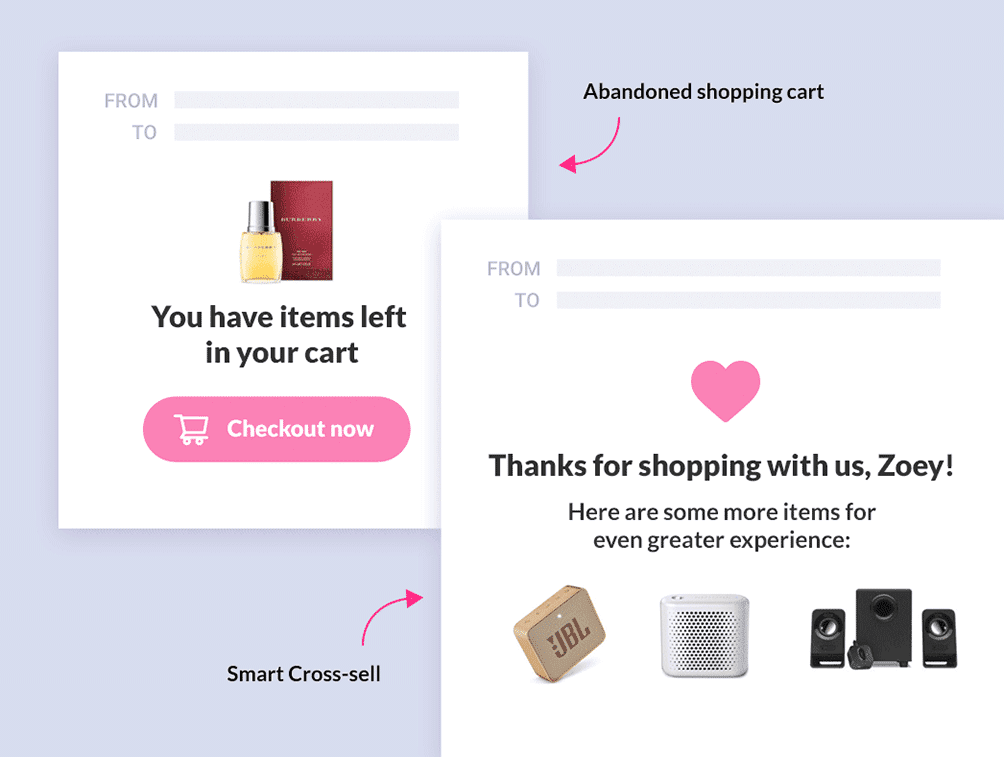Sending your data to our servers, please wait...





Oops... No results found.
Please try a different search phrase.
Email Marketing 17 min read
What Is Email Marketing? (Definition, Types & Tips)
Written by Ayesha Renyard
Content Writer @ Galactic Fed
Expert reviewed by Dallin Porter
Marketing Director @ Galactic Fed
Published 02 Jun 2021
The “email” was invented in the 1970s. In the tech world, that’s ancient! Yet, despite the rise of newer communication platforms, such as SMS and messaging apps, it remains a top digital communication channel today.
The same goes for its place in marketing. Though social media and paid media are the hottest new traffic sources, businesses still see impressive ROI from email marketing. According to Hubspot, email marketing generates $38 for every $1 spent—that’s 3800% ROI!
With that said, Statistica estimates that in 2020 306.4 billion emails were sent and received each day. So while there are many successful email marketing campaigns out there, there are also likely many that are…not-so-successful. (We’ve all been on the opposing end of terrible, spammy marketing emails.)
But yours won’t be one of them. We’re here to help you build a marketing email that’ll stand out in an inbox and score more opens, click-throughs, and conversions.
As part of our Digital Marketing Series, today we’re diving into all things email marketing. By the end of this email marketing guide, you’ll understand what is email marketing, what is email funnel, and three top email marketing best practices to improve your next campaign—so you can see that impressive ROI for yourself.
Ready to click “send?” Then let’s get started.
What is Email Marketing?
Email marketing is a powerful digital marketing strategy that involves sending targeted and personalized messages to a group of people via email. These messages typically promote products and services, or build relationships with customers to nurture leads and improve customer retention. This guide to email marketing will help you understand the advantages and disadvantages of using this marketing channel and provide guidance on how to acquire email lists for your campaigns.
The advantages of email marketing:
- Ownership: You own your subscriber list and are not susceptible to any algorithm changes, platform shadowbans, or anything else beyond your control.
- Cost-effectiveness: Email marketing allows businesses to reach a large audience with minimal investment, leading to a high ROI.
- Measurable Results: Email marketing platforms provide analytics and tracking tools to measure open rates, click-through rates, and conversions, helping businesses refine their strategies for better results.
- Targeting and Personalization: Email campaigns can be tailored to specific customer segments, ensuring the right message reaches the right audience at the right time.
The disadvantages of email marketing:
- Spam Risk: Overloading recipients with emails can lead to being marked as spam, damaging the sender’s reputation and reducing deliverability rates.
- Regulatory Compliance: Navigating various regulations like the CAN-SPAM Act and GDPR is essential to avoid fines and legal issues, which can be challenging for businesses.
- Time and Resource: Crafting effective email campaigns requires time, effort, and expertise in copywriting, design, and email marketing best practices, which may be a challenge for smaller businesses or those with limited resources.
- Slow Growth Rate: In general, growing a subscriber list is more challenging than growing a social following or any other online audience. Unless you already have established communication channels (social media, website, podcast, etc,.) and/or budget for the promotion, the growth rate of the email list might be relatively slow.
7 tips for growing your email list
Yes, growing your email list may take time, but nothing is impossible! Here’s a quick best-practice guide for organically getting more subscribers:
-
Employ all other marketing channels you’ve got at your disposal
-
Offer a “lead magnet” as an incentive to leave an email
-
Don’t buy email lists to avoid being banned from the email platform
-
Follow regulations and the email client’s guidelines to ensure deliverability
-
Craft shareable content and make it easy to share your email
-
Make sign-up forms as short as possible
-
Only send emails when you have something to say, don’t make your subscribers regret they’ve shared their email
What is the Email Marketing Funnel?
Email marketing is all about timing. You have to anticipate the subscriber’s needs and send an email at the right time to elicit action.
The email marketing funnel represents how a subscriber goes from prospective lead to a customer through educational and promotional email communications. Referring to the funnel will ensure that your timing is right—and you’re emailing the right person with the right email at the right time.
As the chart shows below, the email marketing funnel is broken down by the subscriber stage and corresponding campaign goals.
At the top of the funnel, you’ll see goals based on growing brand awareness, building reputation, and showcasing why your products and services are better than your competitors.
Near the bottom of the funnel, you’ll see goals related to converting prospects and turning them into long-term customers.
Source: Lucid Chart
Let’s break it down further with some actionable tips for your next campaign.
Top-of-funnel (TOFU) email campaigns
Before you can even send your first email, you’ve got to get their email first.
Put yourself in your visitors’ shoes. What would someone need to do to get you to give up your email to them?
Let’s say you’re a food blogger. A weekly newsletter offering up new recipes makes sense. For a SaaS company, gated tools, resources, and reports are common lead magnets. If you own an e-commerce business, a loyalty or rewards program is a great way to snag emails.
Whatever it is, it needs to provide clear value. To ensure that, focus your TOFU email messaging on them.
Once you generate a subscriber base, you can start sending out content. To remind you, TOFU content is all about educating your new subscribers about your brand, what you sell, and how it solves their problems.
Here are some types of content that’ll help you do that:
- Blog articles: To create loyal customers, you need to prove that you bring value beyond the service or product you’re selling. If you can offer them quality information on an industry or topic they’re interested in—for free—they’ll be coming back for more!
- Downloadable resources: If you’re not writing blog content, you can still drive value through other resources, such as reports, infographics, and ebooks.
- Video content: Videos are the best way to capture consumers’ attention online because it’s so easy for them to engage. The content should still be valuable, but remember this is also a way to humanize your brand and make it memorable—so make sure to add some personality! Examples include vlogs, viral videos, tutorials, and webinars.
Check out this video explainer video from Panorama 9—an IT management solution. It immediately addresses the target audience’s pain points by summarizing a day in the life—through a video game plot! It’s relatable, provides a solution, and is highly entertaining.
Mid-funnel (MOFU) email campaigns
Mid-funnel content bridges the gap between initial intrigue (at the top of the funnel) and the final conversion (at the bottom of the funnel).
According to the email marketing funnel, prospects are sitting at the consideration stage. You’ve captured their attention, and they’ve given you their email, but now it’s time to prove you’re the real deal. At this point, you can start shifting your messaging on your company and product.
By the way—you should do so quickly! Have a mid-funnel drip campaign ready to launch. Much like being on a dating app and coming across the perfect man or woman, you should assume that they’re talking to other potential suitors—or in this case, your business competitors.
What type of content should you include in this drip campaign? Here are some ideas:
- Case studies: These show your best and brightest results. Plus, they leverage the power of social proof. It’s incredibly reassuring to see other real people using a product and loving it.
Make sure to structure your case studies around a problem and a solution. What is your target audience’s pain point, and how did your product solve this problem for your customer? Need some inspo? Check out these Galactic Fed case studies.
- Blog posts: Blog posts are great for any part of the funnel, really. But for these mid-funnel pieces, we love customer success stories. While case studies strip down a customer’s experience and focus on results, blog posts bring them to life and focus on telling a feel-good story.
- Educational resources: When it comes to your product or services, prospects shouldn’t be fuzzy on how it works or the return it brings. If you have any white papers, videos, or other educational material on your products, send it along, and make sure you have a way to be contacted if they have questions.
Every prospect likes to consume content differently. It’s worth tracking where your subscribers come from and segmenting your mailing list accordingly. Let’s say someone subscribed through your newsletter, while another subscribed through your Youtube channel. The former likely prefers reading long-form content, while the latter probably gravitates towards snack-size, easily consumable content—like video.
The visual below demonstrates a drip campaign based on the user’s behavior. Based on their level of engagement, you can gauge where they are in the funnel and push different materials.
Source: Business 2 Community
Bottom-funnel (BOFU) email campaigns
If prospects have gobbled up all your TOFU and MOFU content, then they’re probably sitting eagerly at the bottom of the funnel. You’ve successfully provoked interest and demonstrated value. Now it’s time to net those conversions and create satisfied, long-term customers.
For these emails, make sure your call to action guides them towards converting, such as claiming a free trial, signing up for a subscription, or purchasing a product.
What types of content fare well in bottom-funnel email campaigns?
- Testimonials and reviews: When you’re about to make a purchase, do you consult user reviews and testimonials? For most of us, seeking reviews acts as a gut check—so include them in your emails to reassure prospects that they’re making the right decision.
- Product and pricing pages: Send them to where the magic happens. Whether it’s the product page or pricing page—give these interested prospects a nudge in the right direction.
If you get them to convert, the BOFU campaigns don’t stop there. To reduce customer churn, you’ll want to keep the content flowing. Oftentimes, people don’t stick around as customers because they don’t see the value.
Sending out support resources—such as video tutorials, webinar invites, how-to guides, or even simple tips via email—helps customers get the most out of your product or service and ultimately see the value.
Email Marketing Best Practices
Now that you understand the marketing funnel and where your next campaign sits, we want to leave you with three email marketing best practices. No matter what sort of email you send, there are certain must-haves that’ll help your email land more successfully—and these are it.
1. Optimize the subject line
Have you ever spent hours crafting up the perfect email, and when you finally pressed send, you saw something like this:
Source: Slipstick Systems
You sigh and quickly make up a subject line. Or, you send anyway, with the ambiguous “No Subject” subject line.
Although the subject line is a mere few words, it’ll make or break your marketing email.
Writing a compelling subject line kind of follows the Goldilocks principle. Here’s what you should consider to strike the perfect balance:
- Keep it simple and focused: Your subject line should clearly reflect what’s inside the email. No need to reinvent the wheel. For example, if you’re offering five top email marketing tips, it should look like this:
Subject line: Five Top Email Marketing Tips Inside!
- Incentivize the open: Whether you’re offering value through an educational piece or promotion, have it at the forefront to score the open.
- Keep it to 10 words or 60 characters: While we want to write something captivating, remember that the audience will only see so much. The word count should always be top of mind.
- Write in the order of importance: Speaking of a short word count, we recommend putting the most important words first! On mobile, your subject line could get cut short.
- Be creative with the preview text: If you feel like your subject line is a bit blasé, the preview text gives you 30-80 more characters to make it more alluring. To add to the example above:
Preview text: Optimizing your subject line is one—what’s the other four?
Source: Proceed Innovative
2. Keep the benefits and call to action above the fold
According to this email marketing study, short emails (50-125 words) receive the best response rate. You may not think that’s enough to show it all off, but it makes sense—marketers have seconds to capture their audience’s attention before they bounce.
To avoid that, don’t save the best for last. Keep all the juicy benefits—and the call to action button—above the fold.
“Above the fold” is marketing speak for the first content your visitors see without having to scroll. Anything that requires scrolling to view is considered “below the fold.”
The image below shows the dimensions that’ll ensure your first impression—above the fold—is flawless.
Source: Freshmail
If you don’t have a fancy banner created, no sweat. Just remember that the opening sentences should mention what you’re offering, its value to them, and how to claim it—so the reader can get straight to converting if they want to. Below the fold, you can get into the details (for those who want the nitty-gritty details).
3. Personalize it!
How often do you receive marketing emails that begin as: “Dear Member”?
Despite many published studies demonstrating the importance of personalization in marketing campaigns, impersonal emails are oddly still common.
Take a look at these findings: 82% of marketers report an increase in open rates through personalized emails compared to generic emails.
It makes sense—consumers have voiced many times that they want personalized buying experiences.
But personalization can mean many things.
An easy first step is to personalize the greeting. Instead of referring to your audience as a “member” or “customer,” refer to them by…their name! (A wild suggestion, we know.) If you’re using a marketing automation platform like Hubspot or Mailchimp, it’s easy peasy. For Mailchimp, you simply paste a merge tag; and for Hubspot, all you have to do is add a personalization token.
And just like that, you’ve shown your audience that they aren’t just another member or customer. Rather, every one of them is valued. And this matters to 84% of consumers.
For further personalization, you can also segment your mailing list according to demographic information, interests, etc. To get this information, ask them a couple of questions when they sign up.
And as you get to know them, you’ll be able to send emails based on their behavior and activity level, as we briefly discussed earlier. For example, if a customer has been inactive for a while, perk them up with an automated email that shares a discount code. Or, if they’re happily making purchases, you can send emails that cross-sell products based on their past buys.

Source: Growmatik
There’s power in personalization. It keeps customers happy—and keeps revenue flowing.
You’ve Got Mail
Now that you know what email marketing is, how the funnel impacts your campaigns, and three best practices—it’s time for you to get out there and send some good old-fashioned emails.
Got writer’s block? No sweat! We’ve got a team of experts that can help clear the way to more sales, signups, and customers.

Ayesha Renyard
Content Writer @ Galactic Fed



